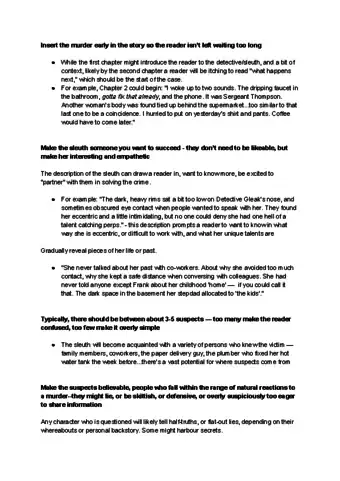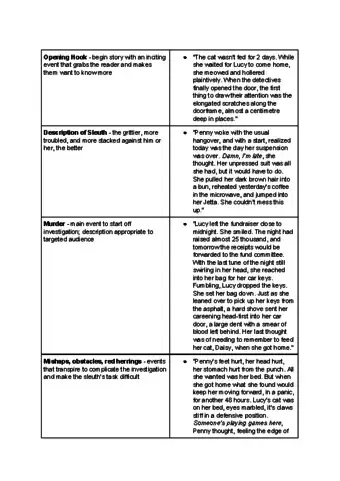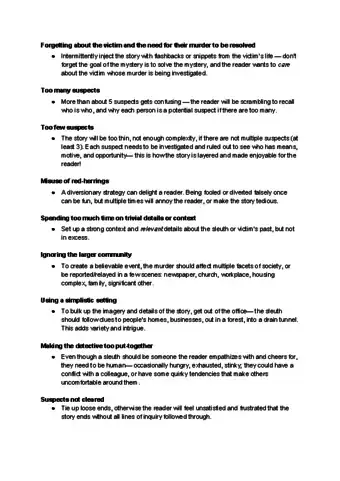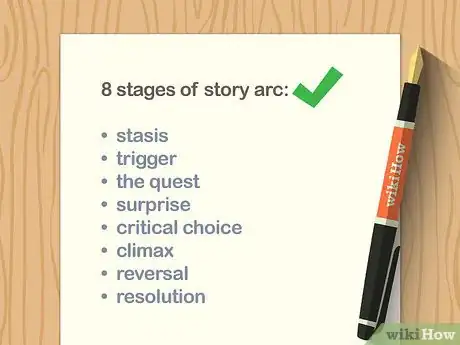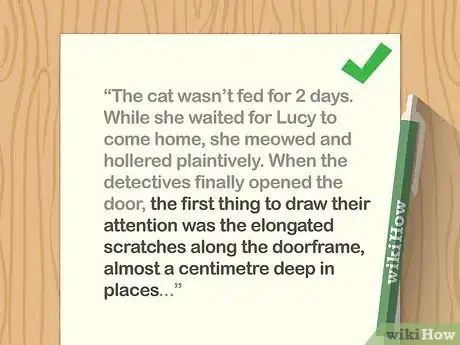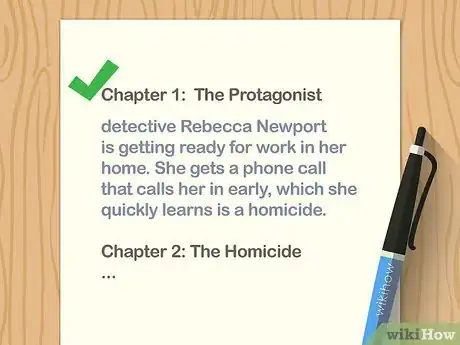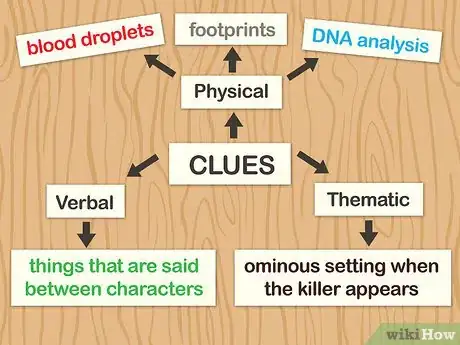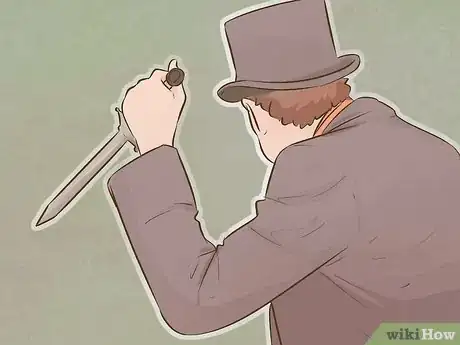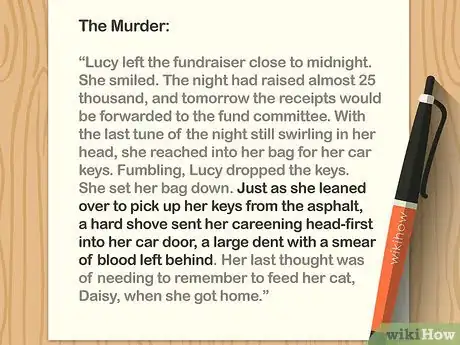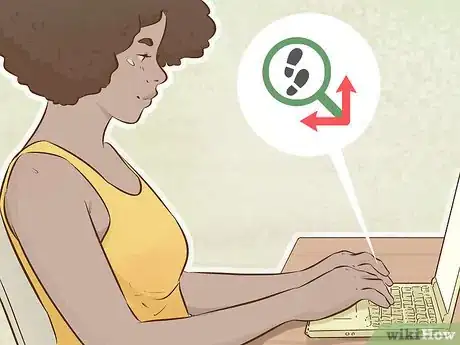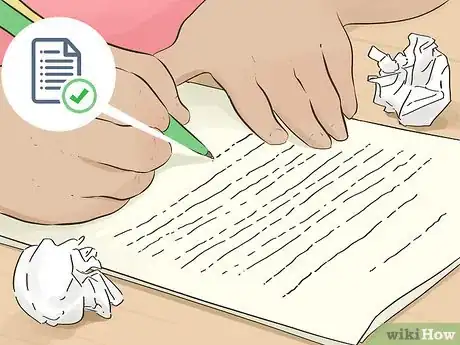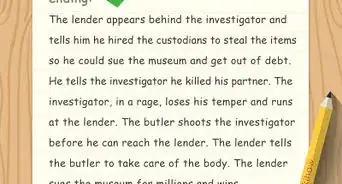This article was co-authored by Lucy V. Hay. Lucy V. Hay is an author, script editor and blogger who helps other writers through writing workshops, courses, and her blog Bang2Write. Lucy is the producer of two British thrillers and her debut crime novel, The Other Twin, is currently being adapted for the screen by Free@Last TV, makers of the Emmy-nominated Agatha Raisin.
There are 15 references cited in this article, which can be found at the bottom of the page.
wikiHow marks an article as reader-approved once it receives enough positive feedback. This article received 13 testimonials and 81% of readers who voted found it helpful, earning it our reader-approved status.
This article has been viewed 240,491 times.
Writing a murder mystery or any novel, really, is a daunting undertaking. Plotting out the novel first can help you organize your thoughts so you won't feel so overwhelmed. Then, you can set up your characters, creating the victims, suspects, and protagonists you'll need to drive the story. After that, you can get started writing your story!
Steps
Plotting out the Novel
-
1Decide on a setting for your story. The setting doesn't necessarily have to come first, but if you have a general idea of what you want your story to be, you also need a setting. Setting includes the location, the date, the time of year, the geography, and even the climate and mood.[1]
- Think about the mood you want to create for your story. The setting partially creates that mood for you.
- For instance, a murder-mystery set in 1920s Galveston, TX during an approaching hurricane is going to be very different from a murder-mystery set in Chicago in present day or Edinburgh in the 18th century.
- As another example, the Sherlock Holmes' stories take much of their darkness and mood from the time period (Victorian and Edwardian era) and the foggy London setting.
-
2Plot your story arc. The story arc is how the plot progresses throughout the novel. Typically, you go through 8 stages: stasis, trigger, the quest, surprise, critical choice, climax, reversal, and resolution.[2]
- Stasis is normal everyday life. You could start with the normal life of the detective, a witness, or whoever's point of view you're using. The trigger is the event that sets off the quest, which is often the murder in a murder mystery.
- The surprise is the twists and turns, the complications that keep the story going. In a murder mystery, that may be things like new evidence, new motives coming to light, or trouble finding a suspect.
- The critical choice is the main crux of the protagonist's story. It's where they must decide how they will act to complete the story, and it often involves choosing a hard path. It is a character-defining moment. This choice typically leads to the climax, the place where the action and tension comes to a head, such as the point where the detective is in the active process of capturing the suspect.
- The reversal and resolution show how the characters have changed and what the new "normal" looks like.
Advertisement -
3Make intrigue the focus of your story. You want to keep the reader guessing throughout the novel. You can start out simply with a corpse and detectives on scene to investigate, but a more interesting story will leave the reader questioning what is going on right from the start.[3]
- Set up an unlikely scenario. For instance, one novelist set up a story where a woman changes her will, forgoing her children and leaving everything to a dying man. Soon, a person is murdered. This setup is so unusual that it leaves the reader wanting more.
-
4Make an outline of where you want the story to go. Once you figure out the basic arc, try making a detailed outline of the story. Go chapter by chapter, and write in a brief description of what will happen. That will make it easier to write when the time comes.
- For example, you might write, "Chapter 1: Introduce the protagonist, the detective Rebecca Newport. Begin in her home, where she is getting ready for work. She gets a phone call that calls her in early, which she quickly learns is a homicide."
-
5Create the physical, verbal, and thematic clues for your reader. Clues basically fall into 3 categories: physical clues, verbal clues, and thematic clues. Physical clues are things like blood droplets, DNA analysis, and footprints. Verbal clues are the things that are said between characters, while thematic clues are things like an ominous setting when the killer appears or dressing the villain in black.
- You can use clues in 2 ways. Immediate clues are things like the killer dropping a piece of jewelry on the way out, which may or may not be noticed by the reader. A future clue is something like DNA analysis, which the reader can't learn about until the detective does.
- There's also a difference in the level of subtlety. Some clues are very obvious, such as a gun left at the scene. Others are more subtle, such as the victim wearing purple, which turns out to help solve the crime.
- You don't need to write all of your clues ahead of time, but you should decide on some key points so you can work them in throughout your novel. You don't want to shove them all into a single scene.
EXPERT TIPLucy V. Hay is an author, script editor and blogger who helps other writers through writing workshops, courses, and her blog Bang2Write. Lucy is the producer of two British thrillers and her debut crime novel, The Other Twin, is currently being adapted for the screen by Free@Last TV, makers of the Emmy-nominated Agatha Raisin.Professional Writer
 Lucy V. Hay
Lucy V. Hay
Professional WriterConsider using misdirection to build suspense. Author and screenwriter Lucy Hay says: "A good mystery will have elements that shroud the central question. The most famous of these is probably the Red Herring, where the audience thinks they know who's responsible, but they're wrong."
-
6Become an expert in your story's focus. To make your reader believe what you're writing, you have to know what you're talking about. If you want to write about a murder connected to Japanese tea ceremonies, you better know all the exacting details of the ceremony.[4]
- You can research on the internet, but don't forget to make use of other resources, such as your local library.
- Research can take you a long way, but experience is often even better. For instance, try attending a tea ceremony if you can.
Creating Your Characters
-
1Create a character sheet for each character. To help you keep things straight, it can be beneficial to make a page for every main character in the story. You can write down things like the character's physical description, their backstory (what happened before the novel), their education level and job, and their personalities.
- You can also include things like their quirks and idiosyncrasies.
- Having these pages to refer back to will help you keep the details straight while you're writing.
-
2Make your characters empathetic, not necessarily likeable. "Likeable" characters tend to be goody-goodies without much depth. To create whole, interesting characters, they need flaws and weaknesses, while still allowing the reader to connect with them.[5]
- For flaws, maybe a character is always late, hates their mother, or doesn't get along with their colleagues. If you need examples, think about people you know or you've met in the past.
- You can make the characters empathetic in a number of ways. They can be having financial problems or be the victim in the story. You can display them being selfless, even when they act with self-interest at other times, such as having a killer who fawns over their cat.
- For instance, Sherlock Holmes isn't necessarily likeable. However, he's interesting, and readers find him empathetic because he is very intelligent and good at what he does.
-
3Include a variety of suspects. Typically, you don't want to point to just a single person in your story as the suspect. Where's the mystery in that? Instead, you should include a variety of people who could be suspects, as many as 5 or 6.[6]
- Variety will keep things more interesting, as well as keep your readers guessing.
-
4Figure out your suspects' motives. Each potential suspect should have a different motive for killing the victim, and each one should be as plausible as the next. Otherwise, the writing can seem a bit flat. For instance, you don't want every suspect's motive to be killing the person for money.[7]
- Instead, you could have one person's motive be they want to keep a secret quiet, another person's be they want the victim's money, while a third suspect's motive could be they were jealous of an affair the victim was having.
-
5Make the murderer believable. The person you finally choose to be your culprit should be capable of the crime on every level. They must be physically able to do it, as well as emotionally. If they're not, your readers are going to feel cheated.[8]
- For instance, a feeble older man is not likely capable of picking up a body and dumping it off a bridge, not matter how much adrenaline is pumping through his system.
-
6Crawl into the detective's head. Often, a murder mystery follows the detective. Whether you tell the story from the detective's point of view (an intense but slightly skewed view) or from a third-person perspective (which gives you a wider view of the story), you should still know your detective inside and out.[9]
- Decide things like: Is the detective completely logical, or do they rely on hunches sometimes? Are they very analytical, looking at every detail, or are they better at the big picture? What are their idiosyncrasies? What helps them think properly? Are they caffeine addicts? Do they sleep at their desk?
- The little details will help the character become more real.
- For instance, Sherlock Holmes is very logical and doesn't rely on hunches at all. But he's also logical almost to a fault, meaning his relationships often suffer because he doesn't rely on emotions enough. Some of his idiosyncrasies include things like needing another person to bounce ideas off of, playing the violin, and conducting odd experiments to learn more about crime-solving.
-
7Set up your victim or victims. You can open the story with the victim already dead, and unspool the details of their life throughout the story. Alternatively, you can introduce the victim in the story as a character, and then move on to the murder.
- When creating your victim, consider how you want them to contribute to the story. For instance, a likeable victim will immediately set the reader against the killer. However, if the victim was a despicable person, the reader may hold out judgment on the killer.
- Create a backstory for the victim to help readers care about them. Introduce it slowly through the story.
- You can even use one of your potential suspects as a victim later on in the story if the murderer kills again.[10]
Setting up the Story
-
1Open with action to draw your reader in. The action could be something dramatic, such as the protagonist in a perilous situation or a glimpse into a later scene in the novel where things are more fast-paced. You could also just use something small to set the hero off on a perilous journey as they are going about their normal routine.[11]
- Don't forget to also include setting details as you go along, so your reader knows where the story is set.
- For example, The Da Vinci Code by Dan Brown opens with the dramatic death of a Louvre curator, instantly drawing the reader in.
-
2Introduce your suspects with interactions and dialogue. One way to introduce your suspects is to have them interact with the victim before the victim dies; the detective will need to witness this introduction. Another option is to have a witness or a connected person name possible suspects to the detective.[12]
- For instance, the detective may witness the suspect and victim having an argument before the victim dies.
- Alternatively, maybe the detective asks a neighbor, "Can you think of anyone who had issues with the victim?" The neighbor might say, "Well, let's see. I have seen a young man visiting late at night when her husband was out of town. I suppose he might be involved somehow."
-
3Include the crime in the first 3 chapters of the story. A murder mystery is a fast-paced story. It shouldn't drag, so if you haven't introduced your crime by the third chapter, you're probably going to lose readers.[13]
-
4Work on realism in your murder scene. As you try your hand at writing a murder mystery, you may realize that you don't actually know that much about killing a person. That's perfectly normal, but you should do some research to make the scene more realistic.[14]
- For instance, stabbing someone isn't as easy as it sounds. It's actually pretty difficult to force a knife into someone, especially someone who's struggling not to die.
- Keep in mind that most "amateur" killers are going to make mistakes. They aren't trained to kill, and most people don't even know how to land a killing blow. What that means is things are going to be messy.
- Put some thought into how someone gets rid of a body. A body is hard to move, plus it's pretty conspicuous. It's also going to leave blood and/or traces of DNA behind, and it will start to smell. Digging a hole takes time, and dumping a body in water could mean it washes back up on shore, for instance.
Telling the Story
-
1Include the suspect interviews gradually and in different settings. If you have each interview in a police interrogation room, that will bog down the writing. Instead, have the detective interview one at the house where the murder was, one at the police station, one outside on the street as the next-door neighbor, and so on.[15]
-
2Give the reader a chance to solve the crime by adding clues throughout the novel. While you can make a fingerprint on a battery in a flashlight appear at the end, that isn't really fair to the reader. Instead, you need to at least show the clue at some point in the story.
- For instance, you might note that a flashlight was left at the scene, but the outside was wiped clean. Alternatively, you can show the fingerprint being lifted off the battery.
-
3Work on misdirection with clues. Clues can point to multiple people at once or to a single person who may seem like the obvious choice for the villain but ends up not being the murderer. This tactic is called misdirection. You show your reader everything, but you point them in the wrong direction.
- For instance, maybe one of the suspects is a hiker, and there are large hiking boot footprints at the scene. In actuality, perhaps the prints were left by a woman who borrowed her husband's boots.
-
4Keep the pace going by sticking to the plot. Throughout the book, you should always leave the reader wanting more, which will keep them turning pages. A murder mystery should be plot-driven, so don't get bogged down in ominous settings and flowery writing. Follow the plot you've laid out so you know where the story is going.[16]
- Similarly, with each chapter, introduce a new element of the story. At the end of the chapter, leave the reader hanging about what happens next. Maybe you introduce a new clue that points to a different suspect, and the reader has to go on to find out if the clue pans out.
-
5Include a twist near the end. A good murder mystery has a twist near the end so that the reader is surprised to find out the ending. The key is the twist shouldn't be so abrupt that it leaves the reader feeling cheated. Rather, it should follow the logic and clues of the story but in an unexpected way.[17]
- For instance, maybe the clues all along point to the murderer being the only son of a wealthy man since he seems to have the only motive. However, maybe the twist is the man had another child, a daughter, who also stands to inherit from the death; the clues should fit both the son and daughter so the reader doesn't feel cheated.
- As another example, one famous murder mystery twist is in the Murder on the Orient Express (spoiler alert!). In the end, the reader/viewer learns all the suspects actually conspired to commit the murder, rather than just one of them.
-
6Work on the reversal and the resolution after the climax. Once the killer is caught, note how your characters have changed for the worse or better. Then show how they return to normal life.[18]
- For instance, maybe the detective crosses an ethical line and decides to leave the force. The new "normal" may be the detective finding a new job.
- Alternatively, maybe the detective is a rookie, and solving the case results in them being promoted.
Community Q&A
-
QuestionHow do I write a report on a murder case?
 Community AnswerInclude the date, who was involved, who was the victim, the time it happened, all your evidence found, and witnesses of the crime.
Community AnswerInclude the date, who was involved, who was the victim, the time it happened, all your evidence found, and witnesses of the crime. -
QuestionIn a murder mystery story, should I reveal the murder at the end, or should I give a cliffhanger and make a sequel? Which one would make a better ending?
 Community AnswerReveal the murder at the end, because you would stretch the plot and people aren't that patient.
Community AnswerReveal the murder at the end, because you would stretch the plot and people aren't that patient. -
QuestionI have my culprit, but I don't know how to link the clues to the correct suspect. What should I do?
 Community AnswerPerhaps rather than having random clues and then trying to link them to the correct suspect, base the clues around the suspect. For example, rather than finding an ax at the scene and then trying to link it to a character with a knife collection, either change the clue to a knife or the suspect to a lumberjack. That is, unless the clue was a red herring to throw the reader off.
Community AnswerPerhaps rather than having random clues and then trying to link them to the correct suspect, base the clues around the suspect. For example, rather than finding an ax at the scene and then trying to link it to a character with a knife collection, either change the clue to a knife or the suspect to a lumberjack. That is, unless the clue was a red herring to throw the reader off.
References
- ↑ http://www.writersdigest.com/tip-of-the-day/discover-the-basic-elements-of-setting-in-a-story
- ↑ https://www.dailywritingtips.com/how-to-structure-a-story-the-eight-point-arc/
- ↑ https://www.esquireme.com/content/20250-how-to-write-a-murder-mystery
- ↑ https://www.thebalancecareers.com/top-rules-for-mystery-writing-1277089
- ↑ https://www.thecreativepenn.com/2014/01/17/writing-crime/
- ↑ https://www.youtube.com/watch?v=r1sMiogOZbU
- ↑ http://elizabethspanncraig.com/mystery-writing-tips/writing-cozy-mystery-suspects/
- ↑ https://www.thebalancecareers.com/top-rules-for-mystery-writing-1277089
- ↑ https://www.thebalancecareers.com/top-rules-for-mystery-writing-1277089
- ↑ http://elizabethspanncraig.com/mystery-writing-tips/writing-cozy-mystery-suspects/
- ↑ https://www.thecreativepenn.com/2014/01/17/writing-crime/
- ↑ http://elizabethspanncraig.com/mystery-writing-tips/writing-cozy-mystery-suspects/
- ↑ https://www.thebalancecareers.com/top-rules-for-mystery-writing-1277089
- ↑ http://www.springhole.net/writing/things-about-death-dying-and-murder-writers-need-to-know.htm
- ↑ http://elizabethspanncraig.com/mystery-writing-tips/writing-cozy-mystery-suspects/
- ↑ https://www.esquireme.com/content/20250-how-to-write-a-murder-mystery
- ↑ https://www.esquireme.com/content/20250-how-to-write-a-murder-mystery
- ↑ https://www.dailywritingtips.com/how-to-structure-a-story-the-eight-point-arc/
About This Article
To write a murder mystery, start by deciding on a setting for your story, including the location, year, climate, and mood. Next, plot your story arc, which includes the introduction, the surprises that complicate the story, the critical choice the main character must make, and the resolution. Then, create a detailed outline with physical, verbal, and thematic clues that you plan to leave for your reader. After you have a good idea of what your story will look like, work on developing your characters and their motives. To learn how to keep the pace going throughout your murder mystery, keep reading!
